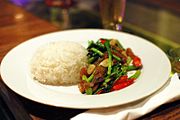- Kai-lan
-
Kai-lan Chinese name Traditional Chinese 芥蘭 Simplified Chinese 芥兰 Literal meaning "mustard orchid" Transcriptions Mandarin - Hanyu Pinyin gàilán, jièlán Min - Hokkien POJ keh-nâ Wu - Romanization kei lei ([ge.le]) Cantonese (Yue) - Yale Romanization gaai3 laan4 Burmese name Burmese ကုက်လန် Thai name Thai ผักคะน้า (phak khana) Vietnamese name Quốc ngữ cải làn or cải rổ Kai-lan 
Kai-lan, cultivar unknownDetails Species Brassica oleracea Cultivar group Alboglabra Group Origin unknown Cultivar group members unknown Kai-lan, also known as Chinese broccoli, is a leaf vegetable featuring thick, flat, glossy blue-green leaves with thick stems and a small number of tiny, almost vestigial flower heads similar to those of broccoli. Broccoli and kai-lan belong to the same species Brassica oleracea, but kai-lan is in the group alboglabra [Latin albus+glabrus white and hairless]. Its flavor is very similar to that of broccoli, but a bit bitter. Broccolini is a hybrid between broccoli and kai-lan, produced by Mann Packing Company, Inc.
Kai-lan is eaten widely in Chinese cuisine, and especially in Cantonese cuisine. Common preparations include kai-lan stir-fried with ginger and garlic, and boiled or steamed and served with oyster sauce. It is also common in Vietnamese cuisine, Myanmar (as ကိုက်လန်) and Thai cuisine.
Gallery
-
Baby kai-lan served Cantonese style
See also
References
Categories:- Brassicales stubs
- Vegetable stubs
- Chinese cuisine stubs
- Leaf vegetables
- Brassica oleracea
- Chinese ingredients
- Cantonese cuisine
- Hong Kong cuisine
- Thai ingredients
- Vietnamese ingredients
- Burmese cuisine
-
Wikimedia Foundation. 2010.


